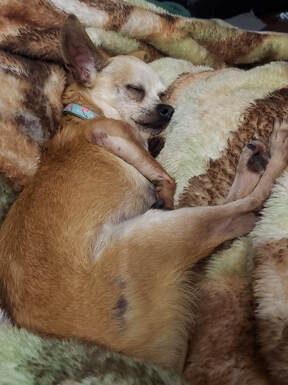
A few tips on how to successfully get through transitioning a new dog into your home with as little frustration as possible for you and your dog. Written from the experiences of our resident assistant trainer, Sarah, who has 10+ years and over 100 dogs worth of rescue experience.
Wherever you are getting your new four-legged, furry friend – these tips will help you and your pup weather the transition to their new environment. Some dogs will be easy-peasy lemon squeezy and adapt to their new environment quickly. Some dogs (especially rescue dogs) may take a little extra time to decompress and adjust.
The three most important things to give you and your pup are: TIME, SPACE and PATIENCE.
TIME ~ Give yourself and your new pup time to get to know each other and don’t judge your progress on any other dog/person relationship. Keep in mind that going at your dog’s pace is key to building a positive, trusting relationship.
SPACE ~ Everyone who gets a dog wants that fluffy, snuggly, lovey beast that worships time and attention while also understanding and respecting space. Think about that: you want your dog to love being loved, but also give you space while you are doing things like dishes, laundry, reading a book, etc. Dogs sometimes also want space and for you to respect that.
PATIENCE ~ Again, don’t compare and/or judge your progress with your dog with any other dog/person relationship. Not all dogs learn things at the same speed. And, depending on what baggage your new pup may come with, you may need to work through more important things like potty training, trust, and boundaries before you can start working on sit, down and other “tricks.” Be patient and give yourself credit for progress you do make instead of worrying about what you haven’t accomplished yet. **Journaling even the smallest things like potty times and naps can give you something to look back at to see your progress in real time.**
Wherever you are getting your new four-legged, furry friend – these tips will help you and your pup weather the transition to their new environment. Some dogs will be easy-peasy lemon squeezy and adapt to their new environment quickly. Some dogs (especially rescue dogs) may take a little extra time to decompress and adjust.
The three most important things to give you and your pup are: TIME, SPACE and PATIENCE.
TIME ~ Give yourself and your new pup time to get to know each other and don’t judge your progress on any other dog/person relationship. Keep in mind that going at your dog’s pace is key to building a positive, trusting relationship.
SPACE ~ Everyone who gets a dog wants that fluffy, snuggly, lovey beast that worships time and attention while also understanding and respecting space. Think about that: you want your dog to love being loved, but also give you space while you are doing things like dishes, laundry, reading a book, etc. Dogs sometimes also want space and for you to respect that.
PATIENCE ~ Again, don’t compare and/or judge your progress with your dog with any other dog/person relationship. Not all dogs learn things at the same speed. And, depending on what baggage your new pup may come with, you may need to work through more important things like potty training, trust, and boundaries before you can start working on sit, down and other “tricks.” Be patient and give yourself credit for progress you do make instead of worrying about what you haven’t accomplished yet. **Journaling even the smallest things like potty times and naps can give you something to look back at to see your progress in real time.**
| First Day/Night – No matter where you get your new pup, how old they are, or what their personality seems to be; the first day/night with your pup can be huge in setting the tone going forward. Don’t be concerned if your new pup seems aloof and distracted, hyper and clueless, shut-down and sad, or even scared and jittery. Most younger pups will adapt and adjust quickly, but our focus here will be on the pups that need a little more of a guide to successfully acclimate to their environment… My most successful set up for all dogs I’ve brought into my home has been to give them a separate, quiet, and safe space away from all other animals and people for at least the first 24 hours. Whether or not they are nervous, this gives them some time to listen to and smell their new environment without any pressure to meet anyone or anydog/cat. This is where SPACE becomes the most important thing you need to give your pup. Pushing them with too much excitement with other pets and people can overwhelm them and create distrust. Which (and how many) of my resident dogs are free-roaming in the house as I take the new dog out to potty and bring them back in completely depends on the body language of the new dog. If they seem friendly and interested in sniffing, I’ll let them greet my calmer more established resident dogs for short bursts each time we move through the house. However, my main focus these first 24+ hours is to get the dogs out to potty and back in safely. We’ll get to dog-dog and dog-people intros later in the week. I also recommend giving your new dog small amounts of food and water more often throughout the first 24-72 hours. Depending on where they came from, travel time to you, and how sensitive their tummies are – giving them normal portions, or free-feeding them, could cause them to eat and/or drink too much too fast which will upset their tummies. Sensitive skin and stomach, or another type of Gastrointestinal food is best when transitioning a new dog if you don’t know or don’t have access to whatever they were previously eating. Potty accidents are almost guaranteed – even for adult dogs that were potty trained wherever they came from. A new environment and schedule means your new pup has to figure out where the bathroom is and adjust to when they’ll be able to get to it. I’ve also had dogs that didn’t eat, drink or potty for days when bringing them home. Unless they seem bloated, straining to go, or generally uncomfortable in other ways – don’t panic. Stress can cause more than just unwanted behaviors, it can make them feel yucky physically. If you do have concerns about their physical well-being be sure to contact your veterinarian. |
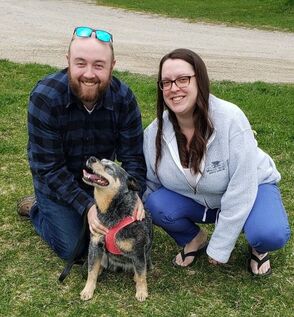
Establishing a Routine –
Beyond just giving your new dog TIME, SPACE and PATIENCE in the first 24+ hours, you should be working to set a routine. Dogs do much better when they know what is expected of them and when. Your schedule may change at times, but the routine should remain as much the same as possible.
Reestablishing or beginning potty training is probably the main focus for most people right away. The general rule for young puppies is that they should be reasonably able to “hold it” for the number of months old they are +1: A 4 month old puppy can (generally) be expected to not have to go potty for about 5 hours. However, when just beginning potty training, they’ll most likely have to go much more often. I generally take new dogs (of any age) out to potty as soon as they wake up from a nap (or get up from resting quietly), any time they stop playing, before and after they eat, after a training session, after they drink and right before bed. As they get used to a routine, the times between trips outside will get longer. Keeping a log of when they go potty and whether they had an accident inside or made it outside can help you establish a routine and see when to start extending time between trips.
It is never too early to start training sessions with your new dog. Just make sure to keep sessions short, to the point and always end on a positive result. If you are working on “sit” work just on that for a short period of time. Once you have been given 2-3 solid correct responses, stop and move on to another topic, or – give your dog a break and come back to training in a while. Training should become a part of your day throughout the day, not just at certain times of the day. Make it part of your routine as much as possible and you will see far greater results more quickly.
Beyond just giving your new dog TIME, SPACE and PATIENCE in the first 24+ hours, you should be working to set a routine. Dogs do much better when they know what is expected of them and when. Your schedule may change at times, but the routine should remain as much the same as possible.
Reestablishing or beginning potty training is probably the main focus for most people right away. The general rule for young puppies is that they should be reasonably able to “hold it” for the number of months old they are +1: A 4 month old puppy can (generally) be expected to not have to go potty for about 5 hours. However, when just beginning potty training, they’ll most likely have to go much more often. I generally take new dogs (of any age) out to potty as soon as they wake up from a nap (or get up from resting quietly), any time they stop playing, before and after they eat, after a training session, after they drink and right before bed. As they get used to a routine, the times between trips outside will get longer. Keeping a log of when they go potty and whether they had an accident inside or made it outside can help you establish a routine and see when to start extending time between trips.
It is never too early to start training sessions with your new dog. Just make sure to keep sessions short, to the point and always end on a positive result. If you are working on “sit” work just on that for a short period of time. Once you have been given 2-3 solid correct responses, stop and move on to another topic, or – give your dog a break and come back to training in a while. Training should become a part of your day throughout the day, not just at certain times of the day. Make it part of your routine as much as possible and you will see far greater results more quickly.
| Introducing your new dog to other pets/people – Having already established resident dogs can surely aid a new dog in getting the hang of things. It is crucial to a new dog’s well-being for you to stay aware of their body language and keep your introductions to other pets and people short and sweet. Letting dogs just play until they are exhausted is not always a good idea, sometimes you will need to let the dogs hang out and then put everydog away for a nap. It is also best to keep all toys and food put away until you know how the dogs are getting along. Slowly introduce toys only when supervised to best avoid issues with resource guarding. Slowly introducing new people and giving your dog the option of whether or not they want to interact a lot, a little, or not at all is the best way to show your dog that you respect their space and level of sociability. Not all dogs want to be around lots of people, and that’s ok. Of course we want every person to love our dog as much as we do, and we want our dog to be a social butterfly, but that’s just simply not always what our dogs want. Most of my resident dogs love every person they meet, or are at least indifferent to people coming to the house. However, I do have a dog that would rather not be a part of the party, he is much happier being in his kennel or room while we have guests over. |
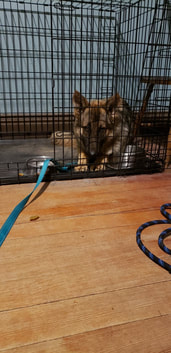
Give yourself credit where credit is due –
Again, the timeframe for progress with individual dogs will vary, there’s a general meme shared among rescue groups with varying descriptions of the 3 day/3 week/3 month rule. I don’t like to put numbers on these things as it tends to create a need in people to be at a certain place in a certain timeframe. It also tends to cause frustration and get people “stuck” on one thing because they’re not “where they should be” according to what they read is the “norm.”
My general advice to people when they get a new dog is to not look at how long it is taking for the dog to learn each individual skill, but to keep track of whatever progress is being made in whatever areas progress is being made. It is very easy to want to give up on a task if you are only thinking about the negatives associated with it. This doesn’t mean that I have never sat in the middle of my floor with a bottle of wine, wondering at my level of sanity, while 2 or 3 rescue puppy fosters chew on everything they shouldn’t, have accidents even though we JUST WENT OUTSIDE, cry, bark, play, irritate each other and my dogs, chase the cats… you get the idea. It just means that I take that time to let go for a minute (or 30) while plotting my next move to restore some semblance of order.
It’s also absolutely OK to admit you are in over your head and need assistance. Not everyone is as willing or able as the next person to face certain challenges head-on without support. Any time I get to a point where I don’t know what to do next, I reach out to my rescue family and my training family for help. It is also absolutely OK to put your dog in a crate or other safe space and just step away to recombobulate yourself. The challenge won’t magically go away, but your level of frustration and anxiety over it will diminish and you can take a different approach and work at it from a different perspective.
I have fostered well over 100 dogs in my 10+ years volunteering with rescues: puppies, adults, all different breeds and personalities. I have spent many a day and night questioning my sanity while seriously considering throwing in the towel and just letting the dogs have the house. But every time I get to that point, I think of the last time I was at that point and how things eventually started to get better. There’s nothing quite like the feeling that comes over you when you see something finally “click” for your dog. It’s quite magical, hold on to those moments, they will help get you and your dog through those more challenging moments.
Again, the timeframe for progress with individual dogs will vary, there’s a general meme shared among rescue groups with varying descriptions of the 3 day/3 week/3 month rule. I don’t like to put numbers on these things as it tends to create a need in people to be at a certain place in a certain timeframe. It also tends to cause frustration and get people “stuck” on one thing because they’re not “where they should be” according to what they read is the “norm.”
My general advice to people when they get a new dog is to not look at how long it is taking for the dog to learn each individual skill, but to keep track of whatever progress is being made in whatever areas progress is being made. It is very easy to want to give up on a task if you are only thinking about the negatives associated with it. This doesn’t mean that I have never sat in the middle of my floor with a bottle of wine, wondering at my level of sanity, while 2 or 3 rescue puppy fosters chew on everything they shouldn’t, have accidents even though we JUST WENT OUTSIDE, cry, bark, play, irritate each other and my dogs, chase the cats… you get the idea. It just means that I take that time to let go for a minute (or 30) while plotting my next move to restore some semblance of order.
It’s also absolutely OK to admit you are in over your head and need assistance. Not everyone is as willing or able as the next person to face certain challenges head-on without support. Any time I get to a point where I don’t know what to do next, I reach out to my rescue family and my training family for help. It is also absolutely OK to put your dog in a crate or other safe space and just step away to recombobulate yourself. The challenge won’t magically go away, but your level of frustration and anxiety over it will diminish and you can take a different approach and work at it from a different perspective.
I have fostered well over 100 dogs in my 10+ years volunteering with rescues: puppies, adults, all different breeds and personalities. I have spent many a day and night questioning my sanity while seriously considering throwing in the towel and just letting the dogs have the house. But every time I get to that point, I think of the last time I was at that point and how things eventually started to get better. There’s nothing quite like the feeling that comes over you when you see something finally “click” for your dog. It’s quite magical, hold on to those moments, they will help get you and your dog through those more challenging moments.
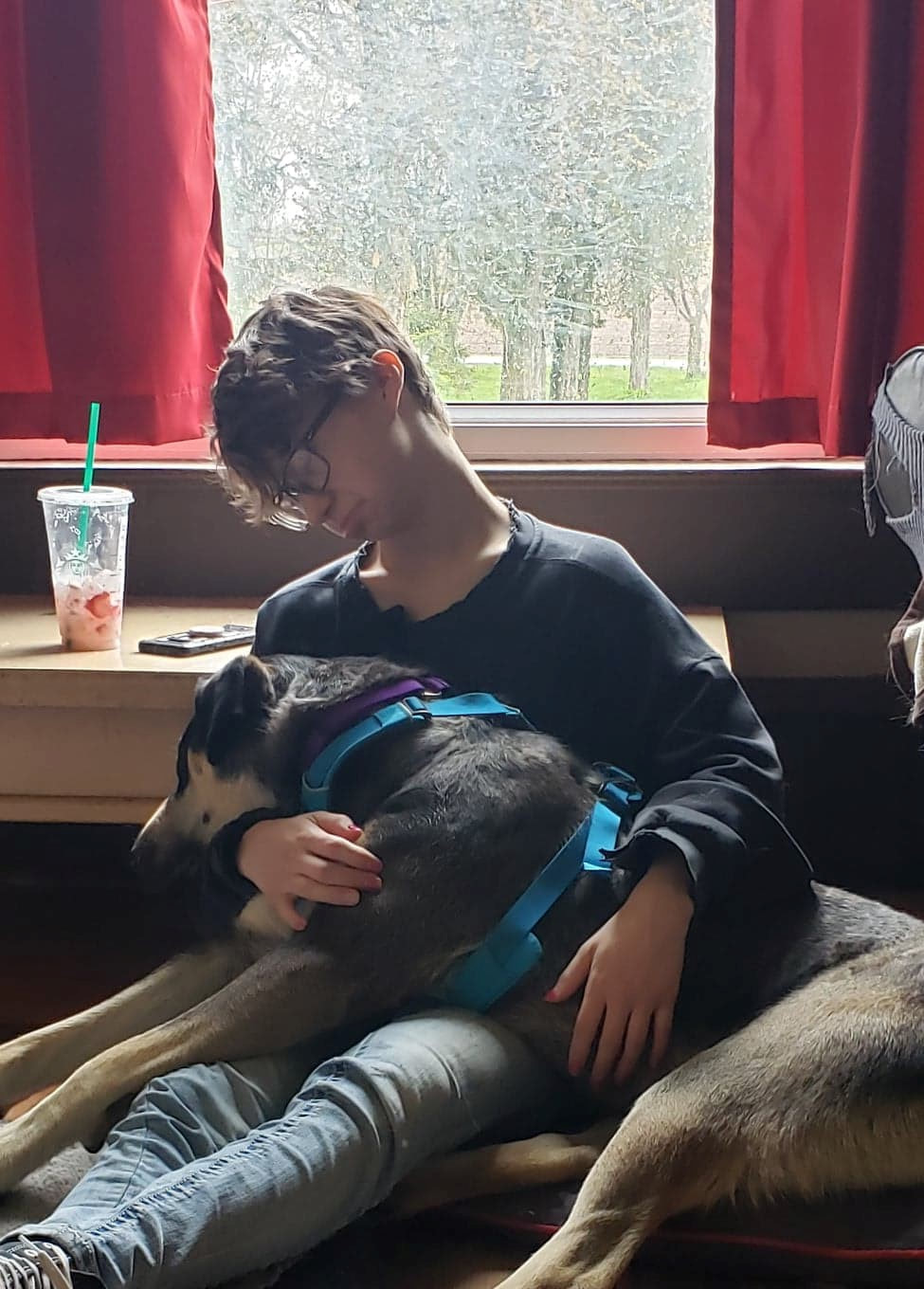
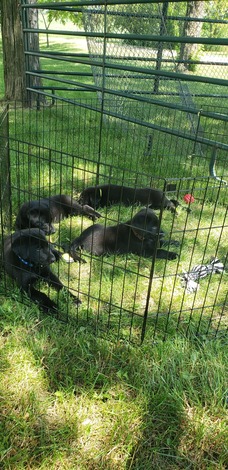
 RSS Feed
RSS Feed